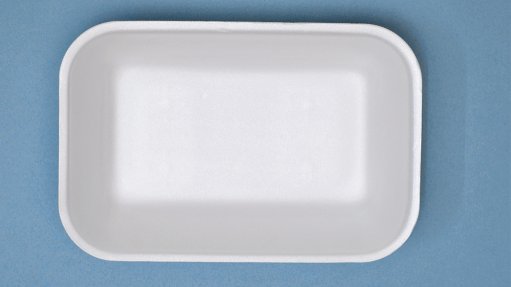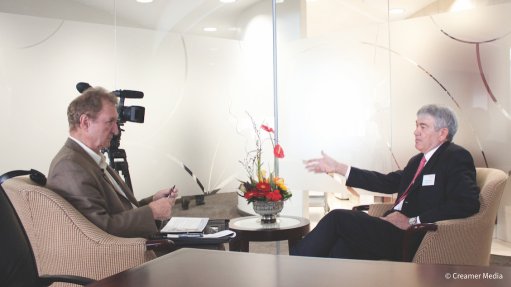Menar envisages reviving Metalloys smelter, selling beneficiated manganese to the world

Menar MD Vuslat Bayoglu interviewed by Mining Weekly's Martin Creamer. Video: Darlene Creamer.
Menar, which recently signed a deal to acquire Samancor’s Metalloys, envisages reviving the ferromanganese smelting complex and exporting beneficiated manganese to the world.
“It’s an exciting project for us,“ Menar MD Vuslat Bayoğlu told Engineering News & Mining Weekly in a Zoom interview.
Menar, a private investment company with a portfolio of diversified minerals that include anthracite, coal and manganese in South Africa, gold in Kyrgyz Republic and nickel in Türkiye, has signed a deal with Samancor, and is in the process of making applications to get the asset into its books.
As part of this process, it has made submissions to the Competition Commission for approvals and also taken steps to have licences ceded to it.
“We’re hoping to close the deal by the end of the year. In the meantime, we’re investigating potential solutions, in terms of what we plan to do with the asset,” said Bayoğlu.
The main reason Menar showed interest in the asset was because of its readily available infrastructure. The rail infrastructure is there to receive manganese from the Northern Cape to feed a smelter that has been consuming two-million tonnes of manganese a year.
“It also has the necessary licences in place, which is another advantage. This is a historical asset, so obviously it has things that need to be fixed. But Samancor did a great job in keeping it intact.
“We’re hoping to do one of two things. We can either build two new blast furnaces that do not need a lot of power and work through coke to make sure that reduction happens. Alternatively, we can look at keeping two of the latest units that were built there and installing new technology,” Bayoğlu explained.
Discussion is under way with a South African company that has developed a new technology that would allow pelletised fines to be fed into the plant, which will require less energy than an electric furnace.
Revival of Metalloys will be an important step towards the reindustrialisation of South Africa.
“These assets are important for South Africa and we need to bring the capacity back so that we can beneficiate the product and sell the beneficiated manganese to the world,” added Bayoğlu.
South Africa is producing one-third of the manganese ore in the world, but selling only 5% of the ferromanganese to the world.
Menar’s diversification into manganese began in 2021 with the East Manganese project in the Northern Cape, where the development of a new underground manganese mine is now at an advanced stage of assessment.
Engineering News & Mining Weekly: What is the latest regarding the underground manganese project you are working on through collaboration with ERG Africa?
Bayoğlu: Because of the acquisition deal with Samancor, it’s more critical for us to be involved in manganese production in the long term. Kongoni is an important asset for us. It’s a large deposit with about 50-million tonnes of manganese underground, and we plan to mine the lower manganese orebody, which has a 36% to 36.5% manganese content. The challenge with developing a new manganese mine is the price of manganese, which has been depressed for a long time. When the incident occurred with South32’s Australian asset, the prices spiked, but they are coming back to the prior lower levels. We need the right manganese price for developing Kongoni. So far, we have done all the groundwork in terms of how we plan to access the ore, how much it will take and how much it will cost us. We did our feasibility and we are waiting for the right price environment to push the start button.
Soon, Transnet is expected to finalise its Network Statement, which details how it plans to work more closely with the private sector. You have indicated in previous conversations that you support such a public-private partnership. How do you think the Network Statement will change or shape South Africa’s rail reform efforts going forward?
This rail reform is critical. Transnet is unfortunately broken. They have two massive issues, including human capital. They ran a process where people were voluntarily retrenched and that caused a huge exodus out of Transnet. The second is the rolling stock issue in that the Chinese locomotives issue has not been resolved yet. A locomotive bought from China sits idle when it’s broken, because they cannot fix it or get spare parts, so that’s a massive challenge. Because of that, government and Transnet decided to go ahead with the rail reform and allow third parties to have access to the rail by paying a fee, and they published the Network Statement. These are all encouraging things but I want to talk about a couple of things such as what is the cost of this access fee going to be, how is it going to be calculated and how will it affect the overall cost of rail. I think Transnet Freight Rail (TFR) is still one of the most competitive rail operators despite all their issues. If the cost of rail for iron-ore miners, chrome miners, manganese miners or coal miners goes up drastically, that is going to affect the viability of mining and exporting products out of South Africa. The other thing is sustainability. They are introducing something new and how is it going to be sustainable? Because there are people trading in different commodities and they want to have access to rail. Are they going to be given a chance to be part of this third-party access? The logistics companies that claim to have access to rolling stock, is that real? Are people waiting with 500 locomotives somewhere and when TFR decides how this rail reform is going to work, will they bring those 500 locomotives and maybe 3 000/ 4 000 wagons and start working? I don’t find this to be realistic.
I personally think that Transnet should consider working with the cargo owners, because we know who the OEMs are, we’ve got long-life mines and we’ve got a lot to lose. But a trading company, when the market is bad, they just stop trading. But we carry on employing people. When the coal price went to $40/t when Covid lockdowns started, we carried on mining but the trading companies stopped trading. We also heard that they are considering doing this on a first come, first serve basis. That’s also very dangerous because who is going to come first? The priority should be given to the cargo owners and the mining companies with mines in South Africa. The duration of the access contract is also critical. It should have enough duration. The other important thing is rail and port alignment. Because if you have been given rail access, but you don’t have the same duration for port access on the other side, then port and rail is not aligned. That is why South African ports like Richards Bay, Saldanha, Gqeberha, East London, Cape Town, Durban should be given priority, because these are ports run by South Africans and mainly Transnet Port Terminals. These are the hurdles we need to pass, but I also think Transnet is on the right track. I think Transnet’s management has the will and motivation to work with the industry. We see an amazing change with the CEO of Transnet and with the CEO of TFR. They are very positive and they are very collaborative in their approach to working with the industry and to making rail work.
Given all the structural and economic challenges South Africa has faced in recent years, how do you think the country’s coal industry should focus, to remain competitive on a global scale, especially with the rise of alternative energy sources?
For South Africa to maintain its position as a competitive coal exporter, we must leverage global demand for coal, particularly from the fast-developing economies in Asia like India, Pakistan, Sri Lanka. All these Asian countries that are benefiting from cheap, reliable, and not weather-dependent sources, like coal and to a certain extent, they also benefit from gas. We need to leverage this because we are close to India in terms of freight distance and India is growing. When China and Australia had a standoff, China bought product from us and there was a massive amount of product going to China. With all these discussions we’re having on renewable energy, battery storage and hydrogen energy, coal is still there. The world is burning eight-billion tonnes of coal per year, which is equal to 250 t of coal every second, 17 000 t per minute or about a million tonnes of coal per hour. So, in six hours the world burns coal that is similar amount to building Egypt’s biggest pyramid. This is the reality and this unlocks the value for wind and solar energy because fossil-based energy is complementary to renewable energy. This includes nuclear energy as well, because at the end of the day, nuclear and fossil-based energy mainly create baseload. The biggest increase in coal consumption happened in India, in 2023. It was 9%. They imported 180-million tonnes of coal and they’re forecasting that this will go up to 200-million tonnes per annum in 2024 and 2025. This means opportunities for South African coal miners because Indian coal-fired power stations, mostly around the coast, are burning South African coal, which is like 5 500 kcal/kg NAR and 4 800 kcal/kg NAR. These are the qualities that they like, so it’s a sad story that we have logistics challenges, because at some point we were able to move 77-million tonnes and we are now in the 50-million tonnes to 60-million tonnes range. We need to go back to the previous range so we can benefit from this market. India burns about 1.2-billion tonnes of coal a year. China burns four-billion tonnes of coal. They buy and produce coal because it’s a reliable, abundant, cheap and non-weather-dependent resource. We have to accept that coal is there, countries are burning coal, and they are growing their economies with coal-fired capacity. At the same time, both China and India are investing heavily in renewables, but that does not stop them from building more coal-fired power stations. China has got more than 1 200 coal-fired power stations. We have 15 in South Africa and countries like the US and India have a large amount of coal-fired power stations and they become competitive because they have a cheap resource to produce baseload. From a coal miner’s perspective, coal looks quite interesting. The market is not bad at the moment. It’s not as good as when the coal price was $150/t or $200/t. It’s sitting between $80/t and $100/t, depending on the quality of the coal. But at the end of the day, we can still employ people, keep their jobs safe and we are motivated to bring more collieries into production. These are positive things for the coal mining industry.
Article Enquiry
Email Article
Save Article
Feedback
To advertise email advertising@creamermedia.co.za or click here
Comments
Press Office
Announcements
What's On
Subscribe to improve your user experience...
Option 1 (equivalent of R125 a month):
Receive a weekly copy of Creamer Media's Engineering News & Mining Weekly magazine
(print copy for those in South Africa and e-magazine for those outside of South Africa)
Receive daily email newsletters
Access to full search results
Access archive of magazine back copies
Access to Projects in Progress
Access to ONE Research Report of your choice in PDF format
Option 2 (equivalent of R375 a month):
All benefits from Option 1
PLUS
Access to Creamer Media's Research Channel Africa for ALL Research Reports, in PDF format, on various industrial and mining sectors
including Electricity; Water; Energy Transition; Hydrogen; Roads, Rail and Ports; Coal; Gold; Platinum; Battery Metals; etc.
Already a subscriber?
Forgotten your password?
Receive weekly copy of Creamer Media's Engineering News & Mining Weekly magazine (print copy for those in South Africa and e-magazine for those outside of South Africa)
➕
Recieve daily email newsletters
➕
Access to full search results
➕
Access archive of magazine back copies
➕
Access to Projects in Progress
➕
Access to ONE Research Report of your choice in PDF format
RESEARCH CHANNEL AFRICA
R4500 (equivalent of R375 a month)
SUBSCRIBEAll benefits from Option 1
➕
Access to Creamer Media's Research Channel Africa for ALL Research Reports on various industrial and mining sectors, in PDF format, including on:
Electricity
➕
Water
➕
Energy Transition
➕
Hydrogen
➕
Roads, Rail and Ports
➕
Coal
➕
Gold
➕
Platinum
➕
Battery Metals
➕
etc.
Receive all benefits from Option 1 or Option 2 delivered to numerous people at your company
➕
Multiple User names and Passwords for simultaneous log-ins
➕
Intranet integration access to all in your organisation



















